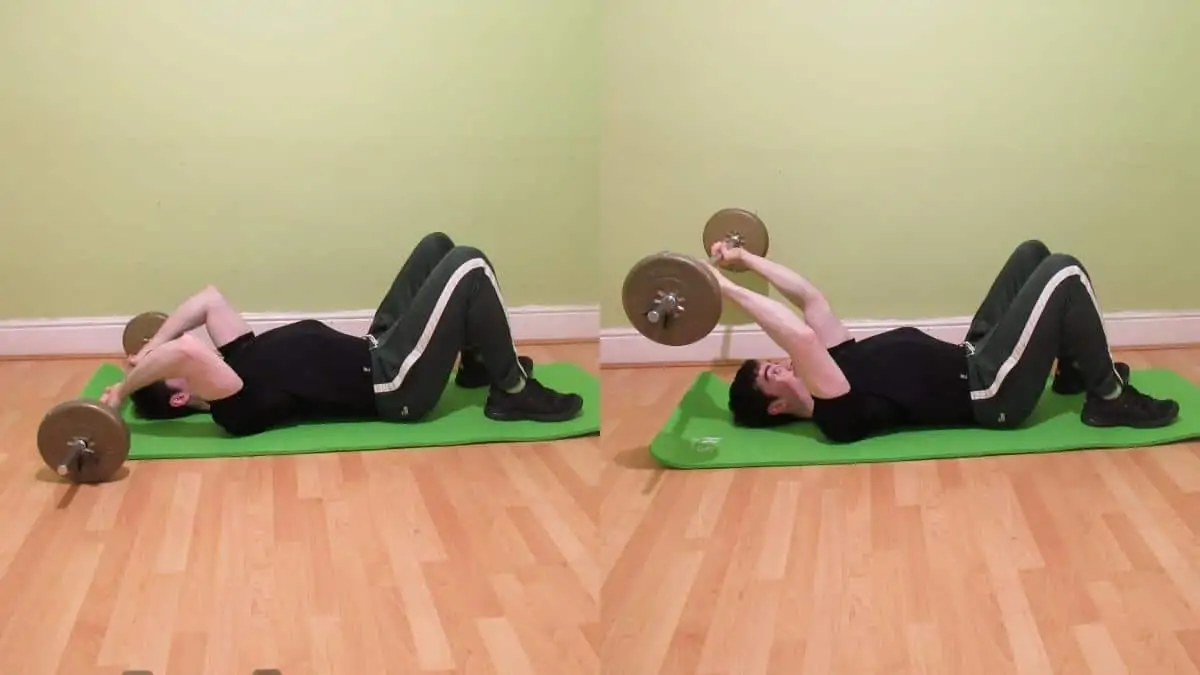Since we already showed you how to do a dumbbell skull crusher on the floor, today, you’re going to learn how to do a tricep extension on the floor with a barbell.
This variation of the lying down tricep extension is ideal if you train at home because you don’t need a weight bench; all you need is some weights and, ideally, an exercise mat.
But if you don’t have access to a bar for whatever reason, then you can also do a dumbbell lying tricep extension on the floor, an exercise that’s great for building proportional arms (because you have to lift each weight independently).
Related: One-arm dumbbell cross body lying triceps extension
Floor tricep extension exercise details
- Main Muscles: Triceps muscles
- Exercise Type: Strength
- Exercise Mechanics: Isolation
- Difficulty Level: Intermediate
- Equipment Needed: Bar, weights, bench
How to do floor tricep extensions
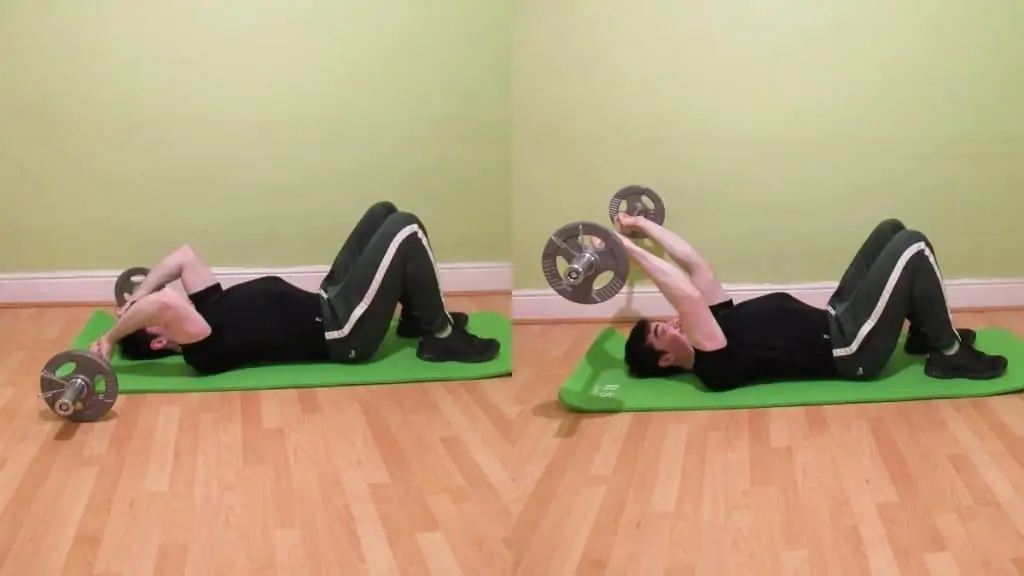
- Place an exercise mat on the floor.
- Load some weight onto a barbell (or an EZ bar) and place it just above the exercise mat.
- Lie on the mat with your feet together and shuffled close to your hips.
- Reach back and grab the bar just inside shoulder width with a pronated grip.
- Flex your triceps to lift the bar off the ground. Keep going until your elbows reach full extension.
- Squeeze your triceps at the top of the rep and then lower the bar in a controlled manner until it touches the floor.
- Repeat for 3-5 sets of 8-20 reps.
Floor tricep extension variations
Besides doing the lying barbell tricep extension, you can also perform the exercise with other training tools to work your triceps from a different angle.
One arm floor lying tricep extension
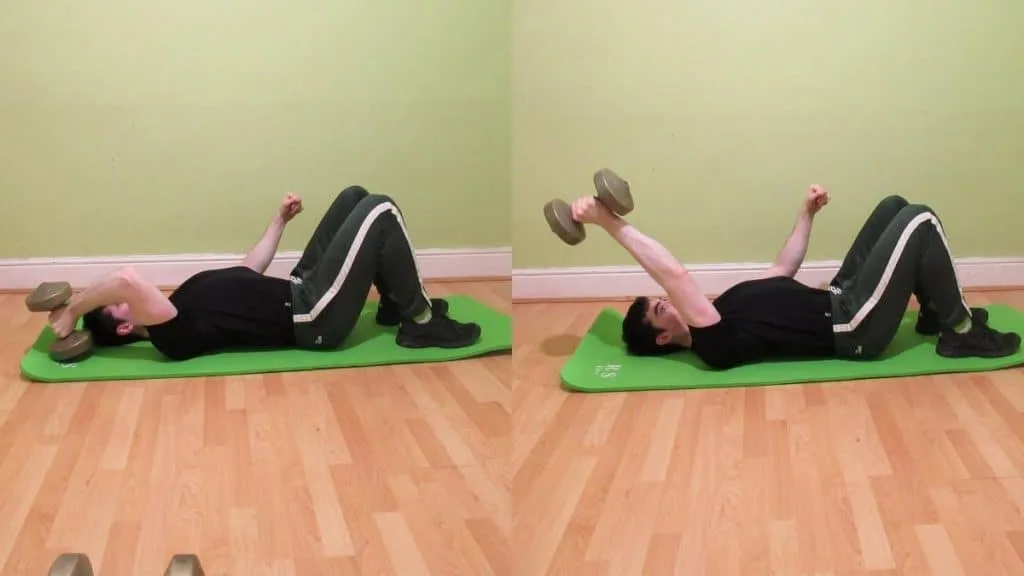
Performing a one arm dumbbell lying triceps extension on the floor is an excellent way to reduce your triceps size asymmetries or to prevent them from cropping up in the future.
When you lift one dumbbell at a time, your brain doesn’t have to split its focus. In other words, it’s much easier to focus on moving one limb than on moving two limbs.
As such, each of your triceps gets a better workout because you can evoke a stronger mind-muscle connection due to the enhanced focus that unilateral training gives you.
So if you want to ensure that your triceps are growing at equal rates, then it really pays to train them separately where possible, especially during your isolation exercises.
Another benefit of single-arm floor DB tricep extensions is that you only need one dumbbell. So if you don’t have much equipment or can’t find a pair of dumbbells of equal weight, then doing single-arm tricep extensions on the floor means that you don’t have to miss out on muscle growth.
Alternating tricep extensions on the floor

Performing dumbbell alternating lying triceps extensions forces you to lift each weight independently, which in turn makes sure that both of your triceps are getting similar amounts of stimulation.
While you will still have to hold both of the weights, you’re not actually lifting them together.
However, since you’re performing your reps in an alternating fashion, this exercise is much more time-efficient than the single-arm version because you can complete your sets more quickly.
Moreover, since each of your triceps gets a short break while the other is working, your muscles will naturally be fresher for each rep. Thus, you’ll be able to perform more total reps on each set, which is a convenient way of accumulating extra training volume without doing any more sets.
Pronated floor tricep extension
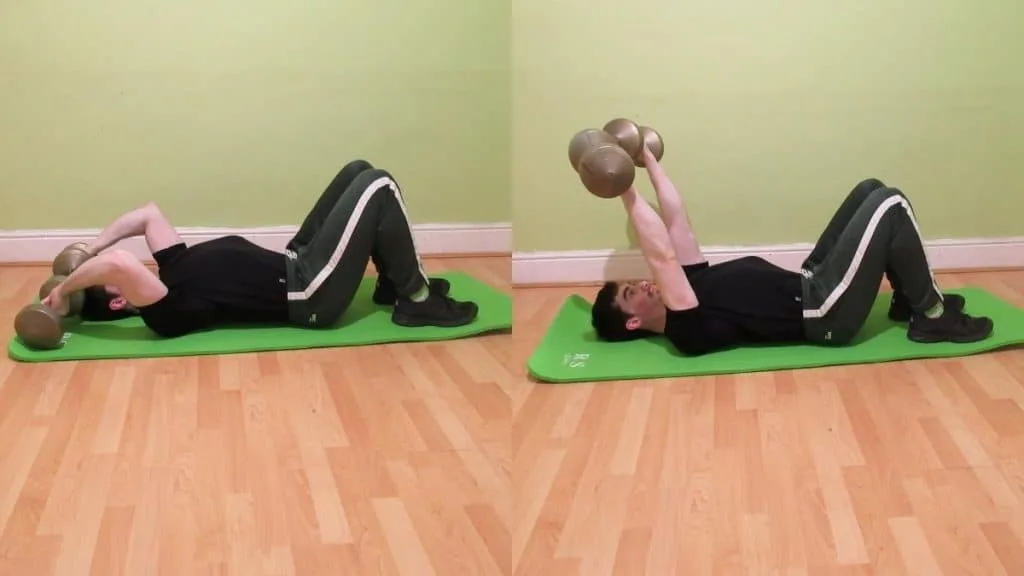
Many people like pronated triceps extensions, but we don’t.
To be sure, pronated tricep extensions are a good exercise; they’re just not optimal.
Since dumbbells have straight handles, holding them with a pronated grip can put a lot of pressure on your wrists.
Instead, you should use a neutral grip to keep the strain off your joints.
Additionally, pronating your wrists doesn’t affect triceps activation because, as elbow extensors, the triceps aren’t influenced by your hand and wrist positions in any way.
Only the position of your shoulder affects triceps activation. And even then, it’s only recruitment of the long head.
So don’t both pronating your wrists when you’re doing lying tricep extensions on the floor. All it does is put extra pressure on your joints and force you to use less resistance as a result.
Side leaning triceps extensions
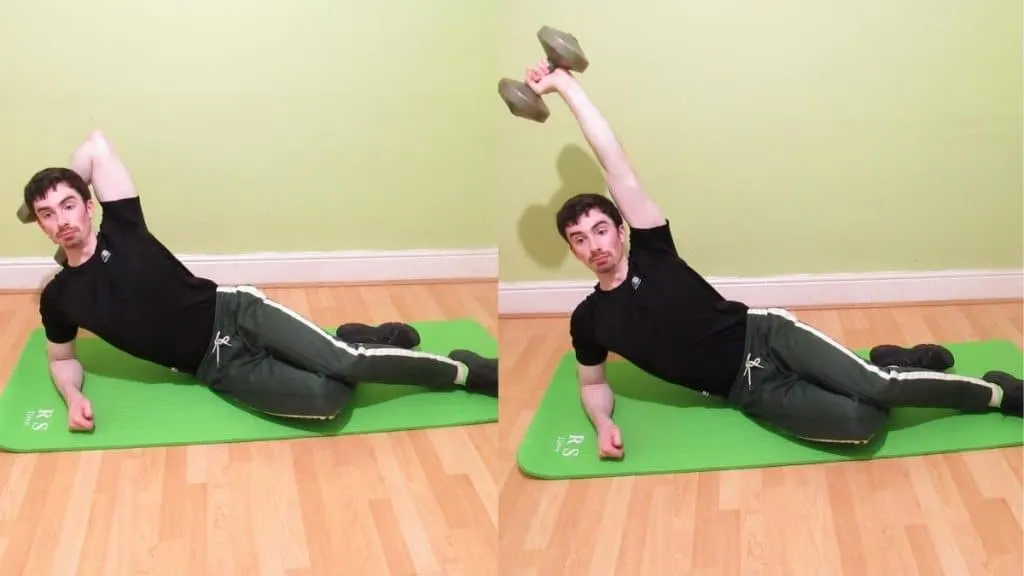
Side leaning triceps extensions are another good floor tricep extension variation because you only need one dumbbell to perform them optimally.
You might find the side-leaning position more comfortable than the lying position since you’re using your spare arm for support and stabilization, which may also help you to better activate your triceps.
The downside is that your sets will take longer to get through because you’re training each arm separately.
The one major advantage of this exercise, however, is that it enables you to achieve a completely unobstructed range of motion. In other words, the weights won’t hit the floor.
This extended lifting motion ultimately enables you to provide your triceps with a better eccentric stretch (especially the long head since it acts on the shoulder joint), which in turn leads to greater hypertrophy.
Floor tricep extension advantages
Performing a dumbbell or barbell tricep extension on the floor definitely has its pros and cons. This section discusses some of the plus points in detail while also explaining how to get the most from the exercise.
Standardized range of motion

When lifters perform tricep extensions, they often vary the range of motion (ROM) from set to set.
As an example, many people reduce their ROM in order to lift more weight, which is another word for progressive cheating rather than progressive overload.
But by touching the bar to the ground during every floor triceps extension rep, you can ensure that you’re using the same ROM for all of your sets.
This way, when you do gain strength, you’ll know that it’s as a result of your triceps getting bigger and stronger rather than due to the deterioration of your technique.
The downside is that the range of motion on floor triceps extensions can be quite small, to begin with. So if you have long arms, then it might not actually be possible to put your triceps under a proper eccentric stretch, in which case you should choose a different exercise.
A good tip in this regard is to use smaller weight discs (no bumper plates, please) to extend the lifting motion.
Safe and simple setup
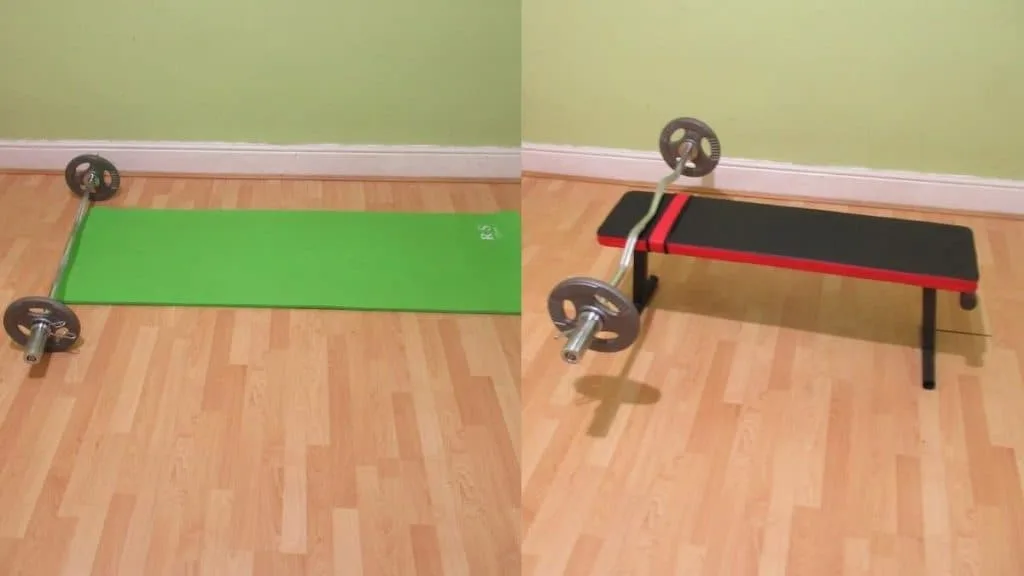
Floor triceps extensions don’t require a bench and, as such, are an excellent exercise if you train at home (or if all the benches are taken at the gym).
Yet, the movement is even simpler to set up than you’d think.
Unlike the bench version, you don’t have to deadlift the bar off the floor and then lie back with it; rather, you lie on the ground and then reach back to grab the bar.
In other words, you’re starting with a concentric repetition rather than with the eccentric phase of the rep. This dead-stop starting position ensures that you’re only lifting as much weight as your triceps can handle over a full range of motion (yes, you should lock your elbows out—that’s the triceps’ main job).
It hits all three tricep heads
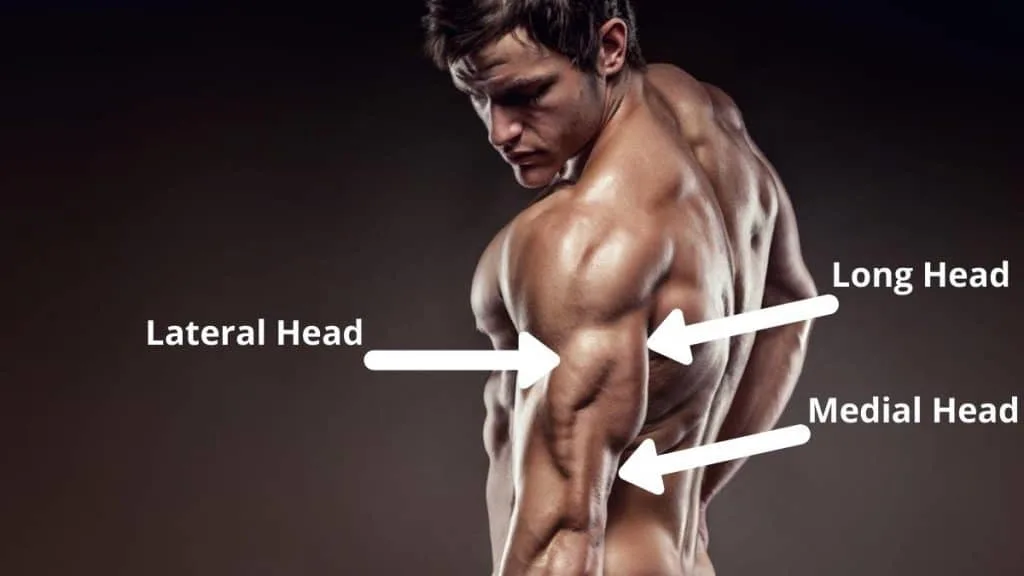
By extending your elbows to full lockout during floor triceps extensions, you’re working all three heads of your triceps. In this regard, floor tricep extensions are a bit like doing a tricep pushdown with dumbbells.
But because you’re bringing the bar behind your head, you’re putting the biggest of those three heads—the long head—under an enhanced stretch because the long head acts on the shoulder joint as well as the elbow joint.
So if you want to gain new arm size, then you need to program the bulk of your tricep isolation training around exercises that have your shoulders in either flexed or extended positions because these are the positions in which the all-important long head is the most active.
Read More: Plank to triceps extension
The verdict: Should you do tricep extensions on the floor?
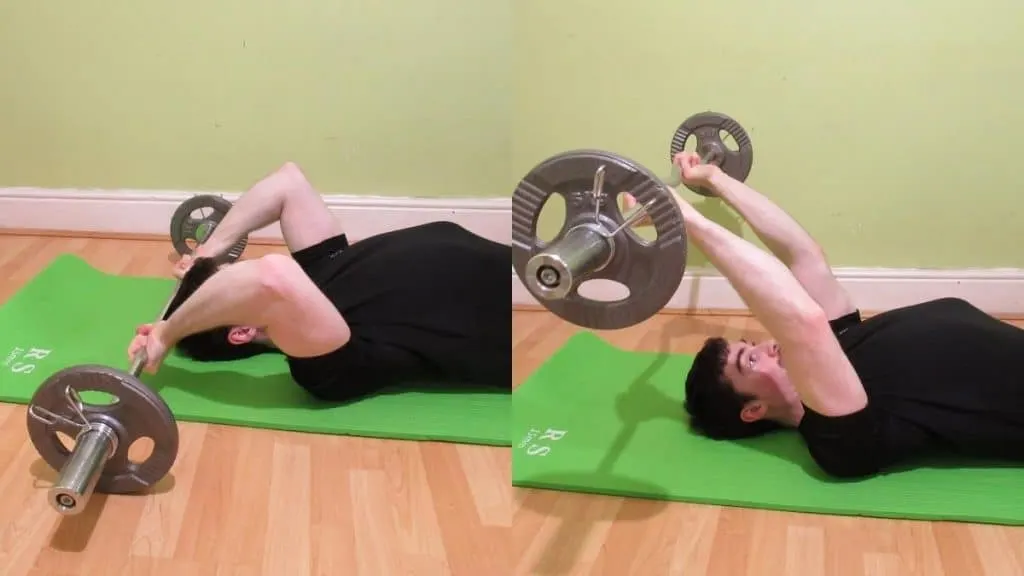
If you’re looking for an effective tricep exercise that’s easy to set up and which doesn’t require much equipment, then the floor tricep extension is the way to go.
Performing tricep extensions on the floor means that you have no need for a bench (though an exercise mat would certainly make the movement more comfortable). This hassle-free setup is ideal if you don’t have a gym membership or if you don’t want to spend much money on workout equipment.
Floor tricep extensions also train all the muscles of the triceps. So providing that you can get a full range of motion (using smaller plates helps here), then the exercise is excellent for building mass.

